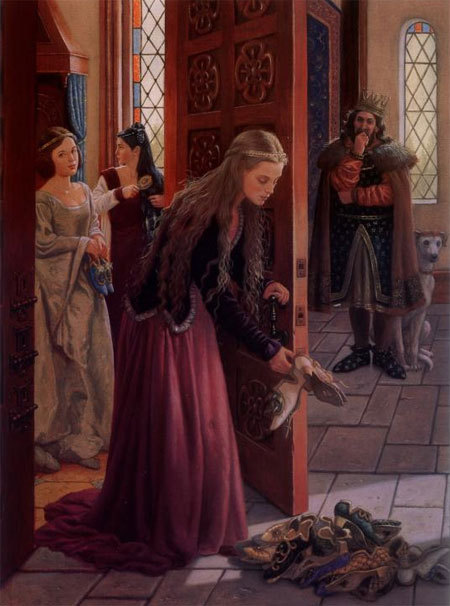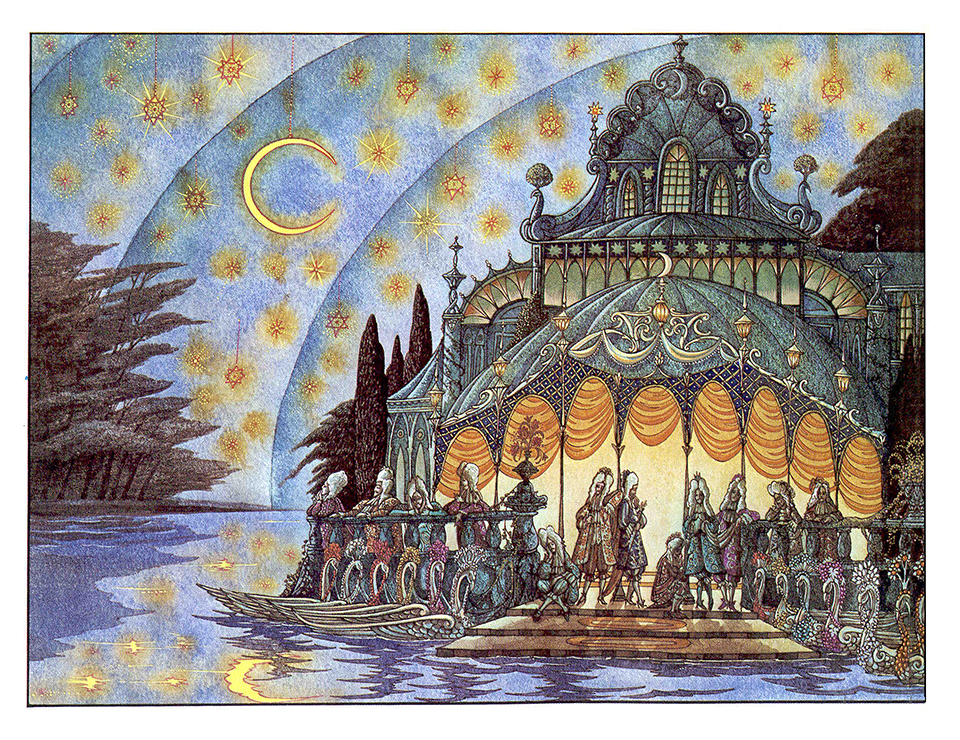Fortunately there are several fictional versions for fans of the story, and there's really so much you can do with the mysterious underground kingdom. Just looking through the descriptions of the plots (Modern Interpretations via Surlalune) each author handles the tale quite differently. As I discovered from Surlalune's book in Underground Kingdom: Parts I and II, even variants of the tale don't agree on what kind of Kingdom it is. It can be evil/neutral/good, and the women in question can go there willingly or as victims.
I decided to check out the novel by Jessica Day George, Princess of the Midnight Ball. It's a fairly traditional retelling of the story but I like how it fleshed out the characters and the plot. It was found in the teen section of my library although it could just as easily have been in the children's section. The writing was easy to follow, and the clues to the mystery a bit obvious, but at the same time it was kind of refreshing to read such an innocent version. The current trend in fairy tales is to explore their darker, adult roots, which I enjoy as well, but sometimes I notice that in order to combat the frilly and saccharine stereotype that fairy tales have, I/the fairy tale community in general tend to get defensive and point out the horrific parts: "fairy tales have VIOLENCE and SEX!" Which is certainly true, but is that why we like them or what makes them good stories?
Anyway, considering the younger audience the writing was pretty good (I would reserve "excellent" for books like Narnia or the early Harry Potters when it comes to children's books). One of my favorite descriptions was of King Under Stone, the ruler of the Underground Kingdom, who was pale and tall and gaunt and had "eyes like chips of obsidian." Doesn't that paint such a vivid picture in your mind?
Ruth Sanderson
And if you're wary of it being too close to the traditional story, George expands the mystery of why the sisters go to the Kingdom every night, and the ending isn't quite as simple as in the Grimm fairy tale, so that part does get a little more exciting. If I were to critique the gender roles-which didn't particularly bother me when reading it-I would wish the girls were a little more proactive, because in this story it's Galen, the soldier, who does all the discovery of the mystery and the ultimate solution to the problem. It's kind of ironic actually-in this old post from 2010 I reflected on the fact that the soldier in "12 Dancing Princesses" doesn't actually do much except for follow the old woman's instructions. It's the females who are having the adventures, and you can surmise that it took something proactive for them to discover the Kingdom in the first place, although that's left up to your imagination. The romance was also too love-at-first-sight for me, especially for a novel in which there is plenty of time to develop a love through multiple conversations.
Errol le Cain
Overall I would definitely recommend it to adults who either are looking for a light and easy read, and/or are wanting to explore some different interpretations of this fairy tale. And I would absolutely recommend it to a younger reader, it could be a great introduction to the world of fairy tales. Traditional novel retellings are great because the stark and odd details of a fairy tale can seem more realistic and personal.
Anyone else who's read it have anything to add? And what other novel versions of "Twelve Dancing Princesses" would you recommend?




Another interesting post! I myself haven't read any retellings of that fairy tale yet, but I've got a few on my to-read list.
ReplyDeleteThat's a very good point of yours, about what makes the fairy tales good or memorable. And then it depends on your definition of dark too. I don't like gore or sex in the fairy tales really, but I like the darkness of some of the stories in that there's something sad that's going on, and something to learn from that. Even though Peter Pan isn't necessarily a "fairy tale" I love how even the original story has dark themes in it, and hidden meanings if you pay attention. How Peter embodied that of the cocky child who won't listen, and how Hook embodied the darker side of being an adult who is constantly running from time and not wanting to die.
My favorite retelling of this fairy tale is Entwined by Heather Dixon. It has a gorgeous, Victorian inspired setting. Also, the main focus is shifted from the soldier and the eldest princess to the family itself: The sisters and their troubled relationship with their father. I enjoyed that shift after reading so many romances in YA books. It's also fun and light, but plays around with some pretty weighty themes.
ReplyDeleteI saw recently -can't think where right at the moment sorry - a post on portals to different worlds and all the ways to travel to get there, what "there" was and who went through, via which door/spell/contraption. It listed everything from Alice in Wonderland, to Narnia, to Dr. Who as well as (I think!) The 12 Dancing Princesses (if that was my brain, then you understand that's just how my brain sees things -always in terms of fairy tales!). Anyway, the idea is really interesting. It's very often females that go through first, or are key players or keepers of the 'door'. You have underground faerie - often men are led there by fae females, the paintings Mary Poppins & co jump into, Persephone in the Underworld, the Little Mermaid changing atmospheres (ooh - now there's a parallel I hadn't considered before) and more I can't remember (I was thinking of them while reading the post but please forgive me - it's late and my brain is on the fried-side).
ReplyDeleteAnyway - re what are we drawn to: for me personally: the fact the fairy tales ARE so dark is so important to me BECAUSE in the middle of the dark is this element of wonder that makes it a fairy tale in the first place. It's not about the magic, but about the possibility of almost anything in the midst of the mundane and amid the trials of hell-on-earth. When fairy tales are all bright and cheerful, I'm a little lost. My world isn't like that. But I've cultivated the ability to find and make magic in the most ordinary of places because of the possibilities fairy tales show me - if you change one thing, sometimes something wondrous happens.
That's my reason anyway. :)
Writer4Christ-Thanks! And stay tuned, a post on the darker side of Peter Pan is coming soon! Just been reading a book on it so it's been on my mind :)
ReplyDeleteClaudia McCarron-I will definitely put that on the top of my to-read list!
InkGypsy-You make a good point. It's probably that combination of darkness+hope that makes fairy tales more memorable, which is why when retellings omit one or the other they are either depressing and pointless, or cheesy and pointless. I mused in a former post about the tale Princess and the Pea and why I think it's not that popular because no one goes through any suffering and it's hard to relate to a princess who is so sensitive
If you find that Portals post again that would be fun to read!